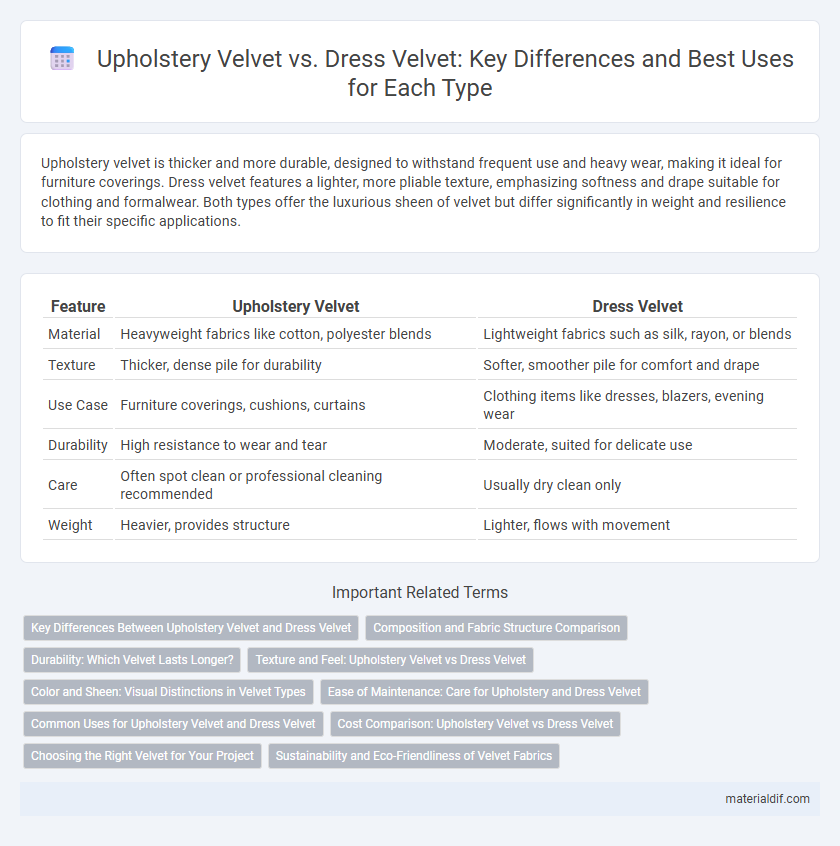Upholstery velvet is thicker and more durable, designed to withstand frequent use and heavy wear, making it ideal for furniture coverings. Dress velvet features a lighter, more pliable texture, emphasizing softness and drape suitable for clothing and formalwear. Both types offer the luxurious sheen of velvet but differ significantly in weight and resilience to fit their specific applications.
Table of Comparison
| Feature | Upholstery Velvet | Dress Velvet |
|---|---|---|
| Material | Heavyweight fabrics like cotton, polyester blends | Lightweight fabrics such as silk, rayon, or blends |
| Texture | Thicker, dense pile for durability | Softer, smoother pile for comfort and drape |
| Use Case | Furniture coverings, cushions, curtains | Clothing items like dresses, blazers, evening wear |
| Durability | High resistance to wear and tear | Moderate, suited for delicate use |
| Care | Often spot clean or professional cleaning recommended | Usually dry clean only |
| Weight | Heavier, provides structure | Lighter, flows with movement |
Key Differences Between Upholstery Velvet and Dress Velvet
Upholstery velvet features a heavier weight and higher durability, making it ideal for furniture coverings and high-traffic usage, while dress velvet is lighter, softer, and designed for clothing and apparel with a more delicate feel against the skin. The fiber composition varies, with upholstery velvet often incorporating synthetic blends like polyester for added strength and stain resistance, whereas dress velvet typically uses silk, cotton, or rayon to enhance comfort and drape. Pile height and density also differ; upholstery velvet has a shorter, denser pile for robustness, whereas dress velvet's longer, plush pile emphasizes luxury and aesthetic appeal.
Composition and Fabric Structure Comparison
Upholstery velvet typically features a heavier weight and denser pile, composed of materials such as cotton blends, polyester, or mohair to ensure durability and resistance to wear. Dress velvet, on the other hand, is often crafted from silk, rayon, or nylon, resulting in a lighter, softer fabric with a finer pile suited for garments. The fabric structure of upholstery velvet includes a tightly woven base with a sturdy pile to withstand frequent use, whereas dress velvet utilizes a more delicate weave with a plush pile that enhances drape and comfort.
Durability: Which Velvet Lasts Longer?
Upholstery velvet is specifically designed for high durability, featuring a denser weave and stronger fibers that resist wear, making it ideal for furniture and heavy-use items. Dress velvet, while soft and luxurious, typically has a lighter pile and less robust construction, resulting in lower resistance to abrasion and a shorter lifespan under frequent use. The durability of upholstery velvet generally exceeds that of dress velvet, ensuring longevity in applications requiring heavy wear and tear.
Texture and Feel: Upholstery Velvet vs Dress Velvet
Upholstery velvet features a denser, heavier texture designed for durability and resistance to wear, making it ideal for furniture and high-traffic areas. Dress velvet typically has a softer, lighter feel with a smoother finish, providing comfort and elegance for garments. The difference in pile density and fabric weight directly influences the tactile experience and suitability for upholstery versus dressmaking applications.
Color and Sheen: Visual Distinctions in Velvet Types
Upholstery velvet features rich, deep colors with a matte finish that enhances durability and hides wear, making it ideal for furniture use. Dress velvet displays brighter, more vivid colors with a pronounced sheen that reflects light, adding a luxurious and elegant appearance suited for fashion garments. The visual distinction lies in upholstery velvet's subtle, muted tones versus dress velvet's vibrant hues and glossy surface.
Ease of Maintenance: Care for Upholstery and Dress Velvet
Upholstery velvet is designed to withstand frequent use and is often treated with stain-resistant finishes, making it easier to clean with spot treatments and vacuuming to maintain its plush texture. Dress velvet, typically lighter and more delicate, requires more gentle care such as dry cleaning and careful handling to avoid crushing the pile or fading. Regular maintenance for upholstery velvet involves less intensive processes compared to the specialized, cautious care necessary to preserve dress velvet's softness and sheen.
Common Uses for Upholstery Velvet and Dress Velvet
Upholstery velvet is primarily used for furniture coverings, cushions, and draperies due to its durability and heavy-weight fabric, making it ideal for high-traffic areas and long-term use. Dress velvet, characterized by its lighter weight and softer texture, is commonly used for evening wear, formal garments, and accessories such as scarves and hats. Both types of velvet offer luxurious aesthetics, but upholstery velvet emphasizes strength and wear resistance, while dress velvet focuses on comfort and elegant appearance.
Cost Comparison: Upholstery Velvet vs Dress Velvet
Upholstery velvet typically costs more than dress velvet due to its thicker pile, higher durability, and enhanced fabric weight designed for furniture use. Dress velvet, while luxurious and softer, is generally lighter and less durable, resulting in a lower price point ideal for clothing applications. Understanding these cost differences helps buyers select the appropriate velvet type based on budget and intended use.
Choosing the Right Velvet for Your Project
Upholstery velvet features a dense pile and durable weave designed to withstand heavy use and resist wear, making it ideal for furniture projects requiring longevity and resilience. Dress velvet boasts a lighter, softer texture with a more fluid drape, perfect for creating elegant garments and delicate fashion pieces. Selecting the right velvet depends on project needs; prioritize upholstery velvet for durability and dress velvet for softness and aesthetic flow.
Sustainability and Eco-Friendliness of Velvet Fabrics
Upholstery velvet often utilizes durable, heavy-weight synthetic fibers, which can be less sustainable due to their reliance on petrochemicals and challenges in biodegradability. Dress velvet tends to prioritize natural fibers like cotton or silk, enhancing its eco-friendliness through renewable raw materials and biodegradability. Choosing plant-based fibers and production methods with lower environmental impact significantly improves the sustainability profile of velvet fabrics across both categories.
Upholstery Velvet vs Dress Velvet Infographic

 materialdif.com
materialdif.com